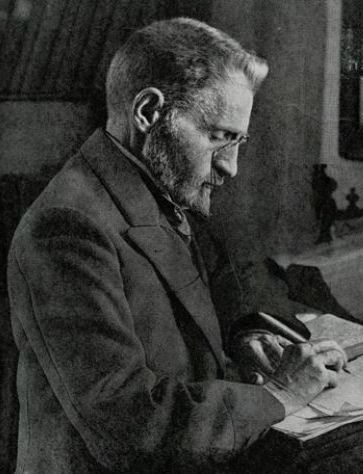| |
2015 |
|
| Browse our
|

Eliezer Ben Yehuda
On Hebrew: The Language that Survived By Jess Chatfield
The following article was written by Jess Chatfield, a staff writer at papers4.sale. It is about Hebrew, a language that has made a long path from being "dead" to becoming "alive." Hebrew language belongs to the Semitic group. This group is a branch of the Afro-Asiatic language family and has common features of phonology, morphology, syntax, and vocabulary. The most outstanding Semitic feature is nonconcatenative morphology. Doubtless, it is not the one and only peculiarity of Hebrew. The whole group is divided into different sub-groups according to their geographical allocation: East Semitic, Northwest or West Semitic, and Southwest Semitic. The total number of Semitic native speakers has reached 470 million people, and it is still growing on. As we have already mentioned, Hebrew is a West Semitic language. Its history is long and complicated sometimes, but it is important to look through key points of it. There are four main periods: · Biblical Hebrew; · Mishnaic Hebrew; · Medieval Hebrew; · Modern Hebrew. Biblical Hebrew. There are many Biblical notes about Hebrew usage: Jesus knew and spoke Biblical Hebrew. First of all, Hebrew appeared as a spoken language during about 1200-586 B.C.E., and Jews spoke Hebrew until the fall of Jerusalem in 587 B.C.E. Mishnaic Hebrew. It is also known as Rabbinic Hebrew. The second period that lasted from 1st to 4th centuries of the Christian Era. The language was influenced by Aramaic, and got its derivation. Medieval Hebrew. The longest period of Hebrew: it lasted from 4th to the end of 18th century. Many countries had influenced Hebrew: Spain and German were the main. It was a decline of spoken Hebrew; two main languages were Yiddish and Ladino. Hebrew language was "dead". Modern Hebrew. This period is dedicated to Hebrew revival. It starts in the 19th century when Eliezar Ben-Yehuda made efforts to embed Hebrew in Israel. The history of Hebrew language is difficult. Being "dead" means not to have native speakers, but this language has become "alive". It is the only case in history when a "dead" language was able to survive and even flourish again. The Zionist Movement (1897-1917) helped Hebrew survive, and the dawn of Hebrew has started. It was founded by Theodor Herzi who had an idea about Jewish emigration to Israel. The ideology of this movement covers basic principles of culture rebuilding, and it has arisen an idea of a revolution in Jewish thoughts. The pioneers of the Zionist movement had several ideas about what their native language should have looked like. They supposed to have French or German as the official language, because none had any idea in what way Hebrew could reborn. It is generally agreed today, that first efforts to reborn Hebrew language had been made in 1882. Once Eliezer Ben-Yehuda said, "The Hebrew language will go from the synagogue to the house of study, and from the house of study to the school, and from the school it will come into the home and. become a living language." (Source) Eliezer Ben-Yehuda (1858-1922) was born in Lithuania, but he started the new modern era for Hebrew. Since the early childhood Ben-Yehuda had ideas about the importance of Hebrew for Jewish people. His biographical data is not only interesting but also significant for the whole Jewish history. Look for more details here on the site. Ben-Yehuda has written his ideas about Hebrew revival in different ways. The most important books are "Hebrew in the School", "Words, Words, Words", "Hebrew in the Home", and his Hebrew dictionary. He goes further in his plans, and asks his first wife to support him. They have decided to grow up their child as the first Hebrew native speaker. The desire for Hebrew revival costs a lot of efforts: family speaks Hebrew, hire nannies who understand it too, isolate their child from other languages. Ben-Yehuda's son, Ben-Zion, has become the first Hebrew native speaker: a boy who speaks, thinks, writes Hebrew. That was the beginning of Hebrew revival. As we can see, Ben-Yehuda insisted on making Hebrew "alive". Jews saw the need of such transformation, so they supported this idea which led to several changes in the educational process soon. The key moments that helped Hebrew survive: 1906 - the first Hebrew school appeared. The first generation of Hebrew native speakers got a chance to study their language. 1913/1914 - students got an opportunity to use Hebrew for education instead of German. Students used German and Yiddish at universities before; and none spoke Hebrew at all. 1918 - the Jewish University appeared. Hebrew native speakers were able to get education in their native language. That was a big leap for Hebrew revival. There were much more efforts to make Hebrew a national language. For example, Academy of the Hebrew Language was established in 1953 to become a new institute for Hebrew revival. Today it helps to enrich Hebrew by following steps: 1. Changing the meaning of some ancient words. 2. Derivation of some new words. 3. Using two or more words for making new word expressions. 4. Words contraction. 5. Using foreign words. Nowadays, over nine millions of Jews speak Hebrew, and they are lucky enough to use their origin language in everyday life. We are proud to be a part of Jewish history of survival! from the 2015 Edition of the Jewish Magazine Material and Opinions in all Jewish Magazine articles are the sole responsibility of the author; the Jewish Magazine accepts no liability for material used. |

|
| All opinions expressed in all Jewish Magazine articles are those of the authors. The author accepts responsible for all copyright infrigments. |



